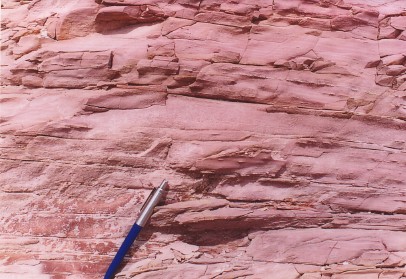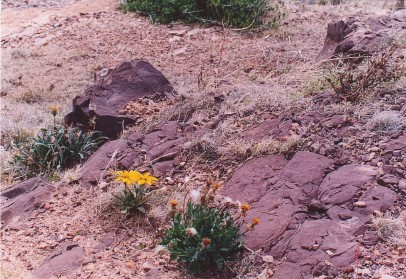The Marinoan, or "upper glacial" sequence
The second, or upper, phase of the Snowball Earth scenario contains what is called
the Marinoan glacial sequence, named after the strata at Marino on the
South Australian coast just south of Adelaide. Often it has been
designated as the Marinoan-Varangerian glaciation. There have been
so many problems brought up with the concept of this being a glaciation
that the proponents of the Snowball Earth scenario have
attempted to split this more recent "glaciation" event and make it two
separate glaciations in order to bolster their hypothesis.
One of the major problems with this sequence or formation is that although
we find it around the earth, we find very little diamictite (which, if
glacial, would be classified as tillite), which would be expected with
massive glaciation. Instead, rhythmites are present, indicating
unobstructed layering. The thick Port Askaig tillite in Scotland
(and its equivalent in Ireland) was thought to be part of the Marinoan
sequence until reclassified as Sturtian due to the fact that the actual
Marinoan rhythmites were found higher up in the strata.
It is true that in several places around the world there are some diamictites associated with this upper
sequence of rocks. However, in South Australia they are localized and are
not extensive. In view of the fact that we seem to be dealing with some
kind of worldwide event, it makes more sense to consider that these
smaller areas of diamictites are the results of localized earth movement.
By the standards of any human being looking on, they would still seem
massive, but on a worldwide scale, they would only be local events.
Again, as in the Sturtian sequence, this Marinoan sequence has a carbonate
layer of rock as a capping, It, also, is world wide. In Namibia, this
capping is over 300 metres thick. By contrast, in South Australia this
carbonate cap is only about 3 metres thick, but in the vicinity of Hallett
Cove, south of Adelaide, its thickness can be measured in centimetres.
This carbonate cap in South Australia is a dolomite called the Nucaleena
Formation, which, despite its thinness, is nonetheless persistent and
is therefore an important geological marker. Below the Nucaleena Formation is the
Elatina Formation, the predominant
stratum that is considered to be Marinoan glacial deposit. This
presumed glacial deposit is present around the world under different
names, according to local geology. It is part of this formation
outcropping in the Flinders Ranges, which showed through paleomagnetic
studies that it had originated near the equator. In the
Adelaide area, this part of the strata is referred to as the Reynella
Siltstone. This is one piece of evidence that
the Snowball Earth theorists use to indicate that the whole globe,
including the oceans, must have been ice-bound if glacial strata are found at sea
level at the equator.
Then there is the evidence presented by the Whyalla sandstone. The
Whyalla sandstone is
immediately west of the Flinders Ranges and is part of the Marinoan
sequence discussed in the preceding paragraph. There is a difference
between the kind of sandstone formed from sand under water and sandstone
from sand blown by wind. Underwater, the layers are flattened out.
But windblown standstone shows the higher angles of deposition which
result from being blown over a dune and layered on the other side.
The Whyalla sandstone has all the characteristics of windblown sand.
This windblown sand is strong evidence that at least part of the earth was
not covered by ice.
In the Elatina Formation, layerings of material can be seen. Very
often this type of layering, called rhythmites, is presumed to be varves.
Varves are laid down by seasonal depositions, and therefore there would be
two a year in any sequence of rock. Often by counting varves, or
presumed varves, in rock, an estimate of the age of the rock is given.
This was also the case in the Elatina Formation. The rhythmites were
presumed to be seasonal. However, as written up in Australian Geologist #117, Dec. 31, 2000, starting on p. 22, in an
article entitled “Proterozoic Equatorial Glaciation: Has Snowball Earth a
Snowball’s Chance?” the evidence is given and discussed that these
rhythmites are not seasonal all, but were rather the result of daily
tides. Therefore the count is two a day, not two a year! This
was also written up in Scientific American of Feb. 1989, starting
on p. 11, in an article entitled “Blame it on the Moon”. The analysis that
Williams, the author of the article in Australian Geologist,
performed on this rock unit
indicated a shallow ocean environment affected by daily tides (this is the
same strata which seemed to show it was from equatorial regions when
tested paleomagnetically).
The reason that this and similar strata around the world are considered
glacial is that occasional dropstones are found within it. It is assumed
that the dropstones in these rhythmites were rafted by ice. However, other
scenarios are possible for the origin of these dropstones and are
discussed later.
The following photographs of the Marinoan deposits are also from near
Adelaide, South Australia.

Exposure of part
of the Reynella Siltstone Member of the Elatina Formation on The Cove
Road, south of Merino Rocks and north of the Hallett Cove railway
stations. The rhythmical bedding and laminae are typical of this
Formation, as is the predominantly reddish colour. The ballpoint pen gives
a size comparison, both above (up to the right) and below. The photograph below shows
details of the bedding and laminae of the Reynella Siltstone in the same location as the
photo above.

* * *

Part of a more
massive unit of the Reynella Siltstone on the coastal cliff-face between
Merino and Hallett Cove.
* * *

An outcrop of Reynella Siltstone can be seen along the cliffs in the upper part of the photograph, forming a deep red line on the coast near Hallett Cove. South of this location, the carbonate capping to the sequence, the Nucaleena dolomite, outcrops near the cliff-face, but is very thin. There is very little similarity between these strata and the Sturtian sequence, except the carbonate capping, so a glacial origin need not necessarily be ascribed to this sequence. Even the carbonate cap is generally admitted not to have formed during the glacial conditions. As the local tillite lenses have an alternative explanation as outlined above, the only evidence left for glacial conditions is the occasional dropstones in the Elatina Formation.
|